NOTE: This is a reprint of a post from December 2018.
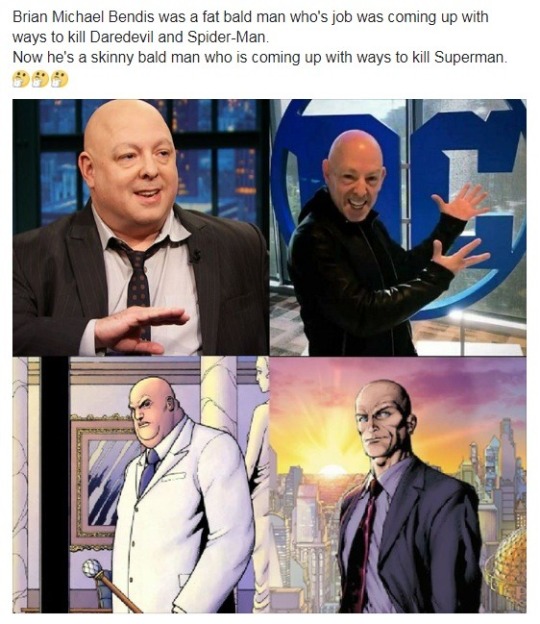
My annual survey of the best monthly funnybooks. This wasn’t a great year for Marvel, which clearly is my personal favorite source for comics, but it turned out to be a truly fantastic year for DC—largely due to Tom King.
And no, Superman isn’t one of them–despite how funny the above photo might be.
Note: I’m focusing on monthly books only—not one-shots—with the exception of one-shot series, like DC’s Earth Two series of graphic novels.
Let’s do this.
Wait. Let’s pause. Before we get started, I want to say that Grant Morrison’s Green Lantern is too new to make the list, but I really like what I’ve seen so far…

Now, click next to start the countdown.
30. Old Man Logan by Ed Brisson and Ibraim Roberson/Old Man Hawkeye by Ethan Sacks and Marco Checchetto (Marvel)
Yes, it’s crap comics. Junk food. Popcorn. But in a year where everything was serious and heavy, having a couple books dig heavily into the Mark Millar world of Old Man Logan was quite needed.
29. X-Men: Grand Design by Ed Piskor (Marvel)
The creator of the seminal comic book history title, “Hip Hop Family Tree,” took on the entire, long history of Marvel’s mutants. It’s heavy on detail, and it’s really best for heavy X-fans.
28. Paper Girls by Brian K. Vaughan and Cliff Chiang (Image)
The book is showing its wear a bit, but it’s still very good. After all, with creators like Vaughan and Chiang it’s almost impossible for it to suck.
27. Cemetery Beach by Warren Ellis and Jason Howard (Image)
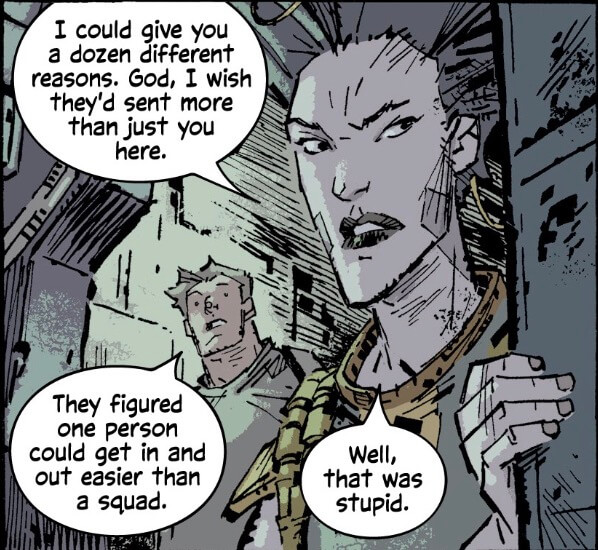
A lone soldier ventures into an alternate Earth to gain intelligence and resources from a group of humans from his own Earth, who colonized it decades before. It’s basically just a long chase, but it’s fun.
26. The Wild Storm: Michael Cray, and WildStorm by Warren Ellis, Bryan Hill, Dexter Vines (DC)

I know a lot of us were looking forward to Warren Ellis reviving WildStorm, but his own book has been a very, very slow burn. It’s good, it just haven’t moved at the pace I expected. Michael Cray, on the other hand, is a rollercoaster. Whether it’s Aquaman as a violent force of nature, Flash as a speed freak, or Wonder Woman as a corporate Goddess, this book has been an exercise in constant reinvention.
Rather than meld WildStorm into the DCU, this book flips it: DCU heroes are the villains, terrible, misshapen representations of familiar characters, and are taken down, one by one, by Michael Cray, whose job is to protect us all from them. A wonderful way to defy expectations. A great comic. I keep waiting for more WildStorm books to come out, but none arrive. In the meantime, these fit the bill.
25. The Dead Hand by Kyle Higgins and Stephen Mooney (Image)
/cdn.vox-cdn.com/uploads/chorus_image/image/59386183/IMG_0124_spread.0.png)
A secret Russian village, hidden away in the mountains, that used to give birth to superspies, now houses a child-like AI with the ability to launch a devastating nuclear attack. It’s a more paranoid, post-cold-war version of Wargames.
Terrific.
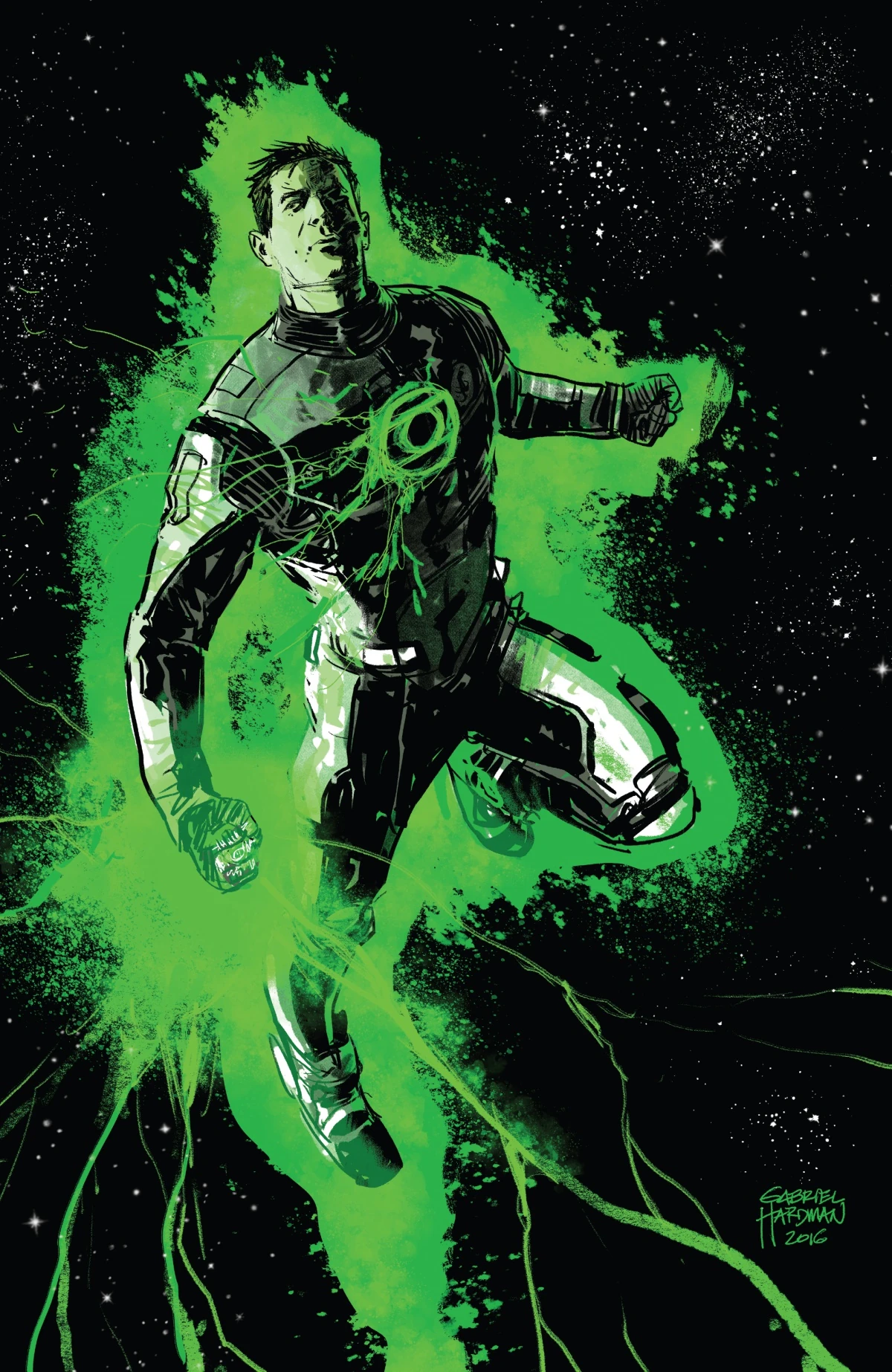
24. The Earth One Books: Wonder Woman by Grant Morrison and Yanick Paquette, Green Lantern by Corinna Bechko and Gabriel Hardman (DC)
I did really enjoy this book, but I did expect a little more from Grant Morrison. I think, in fact, my expectations were simply too high. This was, after all, a very good story.
But liking the Green Lantern book was completely unexpected for me. This has been a good year for the character–and he needed one. He really hasn’t been good since Geoff Johns rebirthed him a decade ago.
23. Infamous and Invincible Iron Man by Brian Michael Bendis and Alex Maleev, Stefano Caselli, (Marvel)
Brian Michael Bendis did a lot for Marvel. He created Ultimate Spider-Man, and wrote it for the entire life of the character. Then he created Miles Morales. He rebooted The Avengers at a time when the franchise was running on fumes, and it made it possible for Marvel to publish more monthly A-books than X-books. He created Jessica Jones. So who would have thought his last Marvel comic would have been the best thing he wrote for them in years?

Issue #600—Bendis’ goodbye to the characters he created and twisted throughout his run, including a new, young black female Iron Man and a version of Dr. Doom out to do good—was phenomenal. He brought back James Rhodes, who had been (stupidly and unnecessarily) killed just to make a Marvel event feel like it “mattered.” After having introduced Tony Stark’s biological mother, he introduced his biological father as a Hydra agent. He brought back Leonardo da Vinci, last seen as a SHIELD founder in Jonathan Hickman’s mind-bending SHIELD series. And he also turned Tony into the Sorceror Supreme—at some future date, perhaps soon perhaps not. And in so doing, resurrected and re-powered the X-Man Tempus, who last appeared in a 2014 X-Men annual where it seemed her story ended with her de-powered and lost in time.
It was a marvelously generous way to conclude a series and leave a publisher. Dan Slott will be taking over writing Iron Man, which is ironic (no pun intended—get it, “iron”-ic?) given that Bendis borrowed from Slott the concept of Dr. Doom as “Infamous Iron Man” after Slott’s controversial and unexpectedly fantastic experiment with Doc Ock being Spider-Man. We can only hope Slott is up to the challenge!
Next: The top 20 begins!
22. Shanghai Red by Christopher Sebela and Joshua Hixson (Image)
A woman is kidnapped to work on a ship in the 1800s, as so many people were, only she “becomes” a man and, in that role, exacts revenge on her attackers. It’s a simple story that begs for a film adaptation, but it’s well-told, well-drawn, and well-crafted.
21. Bloodshot: Salvation by Jeff Lemire and Various Artists (Valiant)

Lemire has been writing the adventures of Bloodshot for Valiant Entertainment for several years now–and it’s still good comics! This year, the character zipped through time to save his son.
20. Quicksilver: No Surrender by Saladin Ahmed and Eric Nguyen (Marvel)

Retelling Quicksilver’s origin by having him literally running through his past, trying to outpace his memories and personal connections before a doppelganger of himself can destroy everyone he loves.
Yes, it’s highly metaphorical, but it was also surprisingly deep and extremely well done.

19. Eternity Girl by Magdalene Visaggio and Sonny Liew (DC)
First of all, Sonny Liew needs much, much more love. His art can elevate a mediocre product into a must-buy. But that’s not what happened here. Rather, Magdalene Visaggio turned in an impressively realistic narrative about depression and suicidal ideation and turned it into a mystical, mind-bending, end-of-the-world comic. If Eternity Girl can’t overcome her own mental illness, the world itself will collapse under the weight of her own depression.
18. Multiple Man by Matthew Rosenberg and Andy MacDonald (Marvel)
Put to one side that nobody other than Peter David has ever been able to make Madrox into anything cohesive, because this miniseries doesn’t do that, either. Instead, it puts us into a world dominated by an evil Madrox, with other clones forming revolutionary armies, and still others infected with gamma rays and all kinds of things to make them super clones of other Marvel heroes. It’s just wild, madcap, crazy fun. Between this and last year’s Kingpin mini, Rosenberg is a writer to watch.
17. Exit Stage Left: The Snagglepuss Chronicles (DC)
Surprised? Well this DC/Hannah Barbera tie-in was actually very cool, and very smart. It takes pace in Senator McCarthy’s 1950s U.S., and Snagglepuss is a gay playwright targeted by McCarthy’s HUAC hearings.
Yes, you read that right. It’s the most unusual commercial property book you’ll ever read
16. Black Panther by Ta-Nehisi Coates and Daniel Acuna (Marvel)
Black Panther in space! I’m pretty sure this book isn’t canon, but it’s a fun way to play with Star Wars tropes and to do something completely unexpected to Marvel’s readers.
15. The Further Adventures of Nick Wilson by Marc Andreyko, Eddie Gorodetsky and Steve Sadowski (Image)
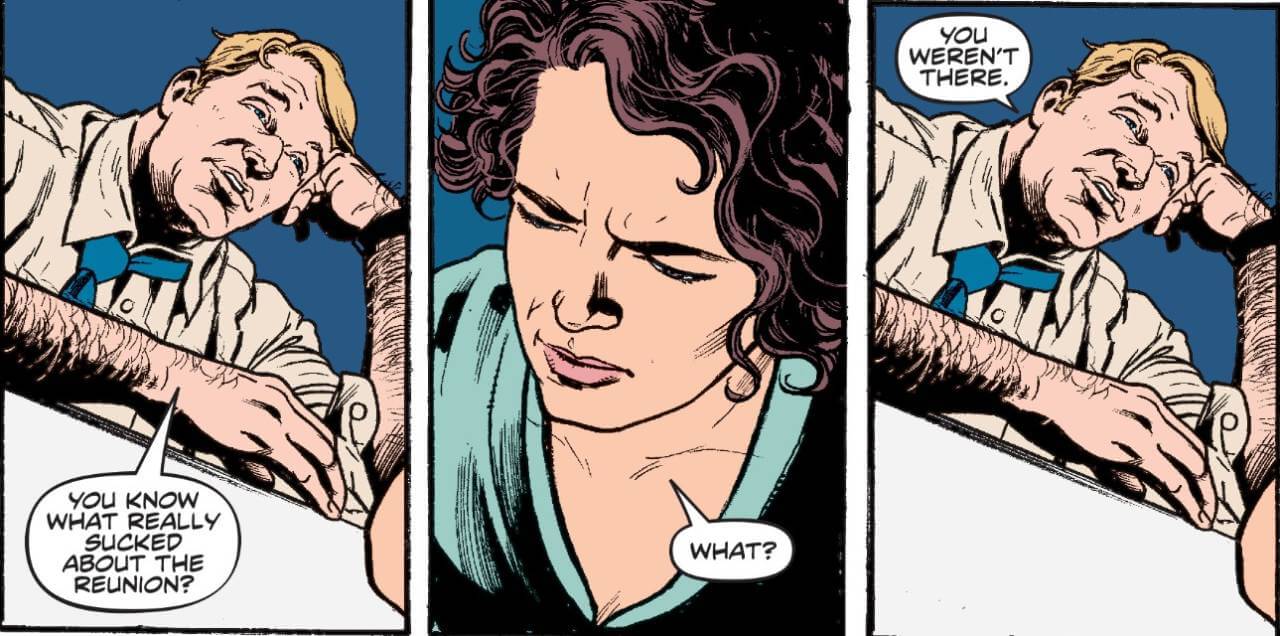
What if you were suddenly Superman? What if you then saved the world a few times, and then your powers went away just as suddenly as they had appeared? That’s the concept of this book, which features no powers and no abilities—just an overweight, average, pot-smoking schlub in his thirties who used to be somebody.
The people in this book look real. Even the love interest is an “average” woman with a realistic body type. And they all act like “normal” people, too, with the same concerns about money, children, and past regret.
If you’re an average guy in your thirties or forties—and if you’re reading comics, you probably are—this book should be highly relatable, and might even bring tears to your eyes. Absolutely great.

14. The Beef by Richard Starkings and Tyler Shainline, Shaky Kane (Image)
The Beef is a crudely drawn (but it works, trust me) piece of vegetarian propaganda dressed up as a comic book about a super-strong guy who gets his powers from cows in a slaughterhouse, and then wreaks havoc on the criminally linked owners of the meat factory.
Interwoven throughout the story are facts about how your meat is raised and murdered, and then how it gets to your table. And also little blurbs about vegetarian heroes like Gandhi, who actually plays a pivotal role in the conclusion of the story.
I don’t eat meat. I haven’t for decades. So for me, this was a brilliant and justified exercise in mixing adventure and education—in a very adult, savagely violent story. If you’re a fan of burgers, though, you may find it unsettling. At least, I hope you do. Because you’re supposed to. But don’t let that keep you away because, as Biggie said, “If you don’t know, now you know.” This is a must read.
In a word: Unpleasant. In two words: Unpleasant and challenging.
13. Days of Hate by Ales Kot and Danijel Zezelj (Image)

Ales Kot does not write accessible comic books, so if you’re looking for an easy read to dive into, go somewhere else. But if you’re up for the challenge, you’ll find a tale of a politically dystopian, post-Trump future (2022) where police hunt down neo Nazis and dissident terrorists, and there are no heroes. It explores contemporary models of “oppression” and victimhood, while at the same time never losing its heart.
There’s a tenderness here, under all the politics and violence, and that lends to the complexity and depth that takes this book out of the realm of the typical polemic and into one with meaning and insight.
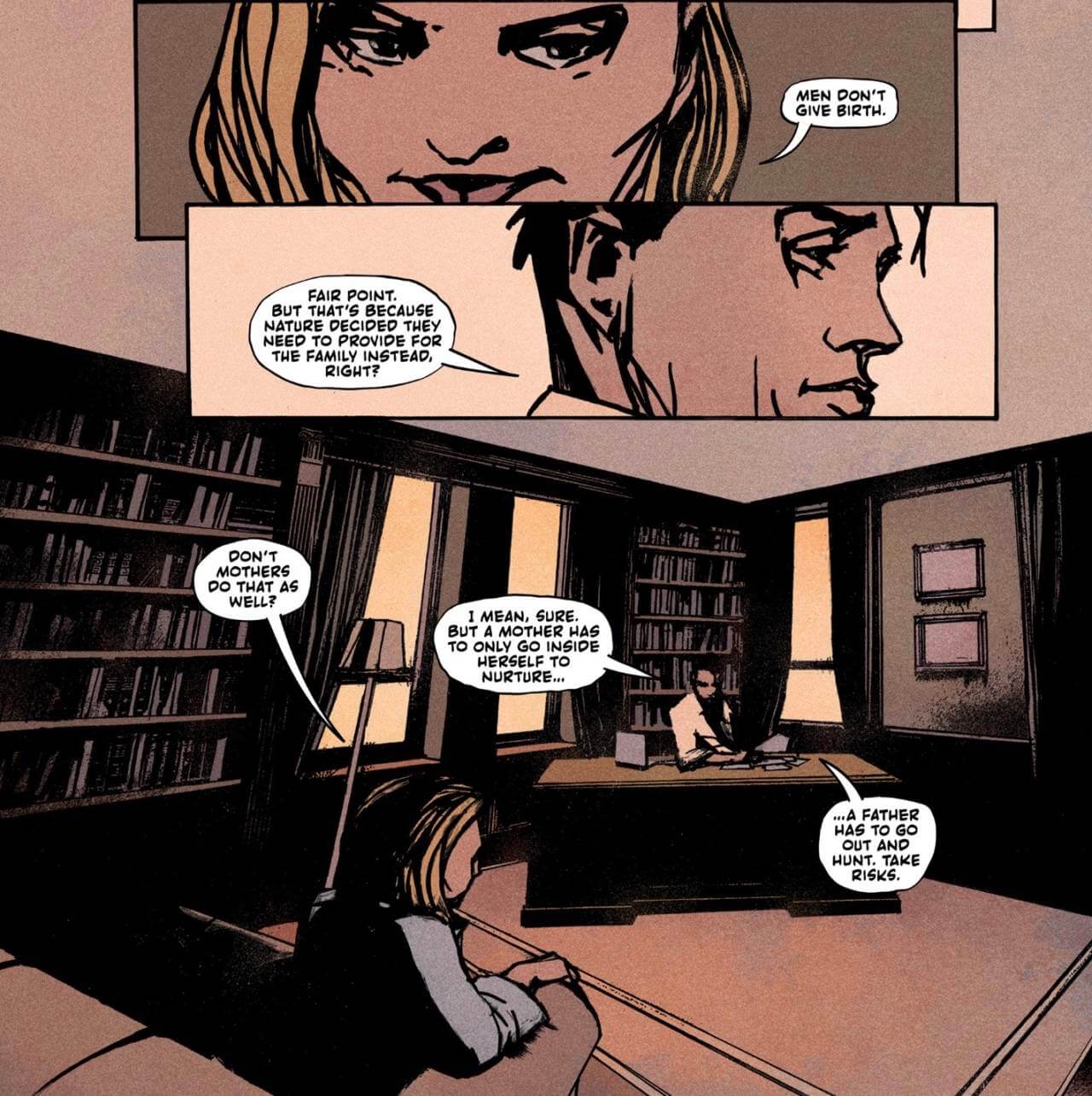
I must say, though, that this was a very hard book to follow—large cast, unclear motivations (which was intentional as part of the mystery of it all), and art that, while very nice to look at, didn’t always make for the most descript characters. However, there were moments of profundity and power in every single issue. Like the above exchange between a woman and her distracted husband. You can see just from those three panels how estranged they are, you can feel how the woman wants to be a part of her man’s life, but his demeanor—down to the arrangement of the panels so that he is looking away from her in panel two—show that it’s a lost cause. And then the words themselves—the fundamental difference between a man and a woman, which is often in our current climate not appreciated as having value but, instead, is seen as something to minimize and discount. Kudos to Ales Kot for recognizing a difference between the genders and not making excuses for it.
12. Abbott by Saladin Ahmed and Sami Kivela (Dark Horse)
A demon noir story of a reporter investigating strange goings on in 1970s Detroit.
If you strip out the horror elements, you get an excellent detective book, full of social commentary on 1970s urban America—under (and over) tones of racial tension and prejudice that resonate today. (Side note: The film Detroit also told of that City’s terrible police state mentality back in the 1970s, and it’s excellent. Check it out.) There were quite a few books that touched on the state of our nation in terms of race, and it was interesting to see one making contemporary commentary but taking place thirty years ago.
But then again, why strip the supernatural parts out of this book? When you add the horror back in, you get the kind of truly multifaceted writing we all should now expect from Saladin Ahmed (based on his work on Black Bolt for Marvel, which was the fourth best comic of last year).
11. Domino by Gail Simone and David Baldeon (Marvel)
Yes, this book has the traditional feel of a modern Marvel comic—it’s got sentimentality and superheroics. But there’s also a deep dark side here, as Gail Simone explores the brainwashing the title character endured as a young girl and exposes Domino’s most violent tendencies.
Credit it to Zazie Beetz’s stellar performance in Deadpool 2—easily the best part of that otherwise underwhelming film—that we get an A-list talent on a solo book of a character many fairly faithful comic book fans don’t know all that much about.

Also: Gail Simone writes Deadpool again! Granted, it’s only a few panels, but Deadpool hasn’t been well-written in ages and Simone was one of the best ever to write the character, so…Yeah!
More so than most books on this list, Domino proves that Marvel can still something that is simultaneously of a high quality, edgy and traditional. And it further cements Gail Simone as one of the best mainstream writers around.
It was a nice year for Simone, who also had a good run on Plastic Man for DC.
10. Infidel by Pornsak Pichetshote and Aaron Campbell (Image)

This was the year that inclusion exploded in comics, and Infidel is a great example. Homosexuals, Muslims, minorities, and white men, all live together, with realistic (i.e., not overblown) recognition of their differences, and with a common purpose: To help each other overcome a threatening presence known fully to only one of them—a supernatural force that feeds on xenophobia.

This book by two unknowns was so good, so powerful, that it got optioned for film after just two issues.
Congratulations, guys!
9. Saga by Brian K. Vaughan and Fiona Staples (Image)

When Fiona Staples and Brian K. Vaughan said #54 would be the last issue of the story for a year, after which they will return and finish the story for good, I was kind of glad—their fatigue was starting to show in recent issues, which were only “very good” and not “great.”
Saga has been in my top 10 series of the year ever since it was launched—often resting at the #1 spot—and the book has won TWELVE Eisner Awards. So it is certainly one of the greatest comics of all time, but is it one of the most important? It’s hard to see it as influential because, frankly, it is so wholly original that it really can’t be copied. And it’s hard to imagine it being adapted—even Vaughan has said he’s not interested in a movie or TV deal. So it’s importance is only that it has elevated the medium and shown how comics—particularly SF books—can have emotional depth, humor, tragedy, and brilliant, wonderful art.
Elevating the medium should be enough. Comics-as-art, comics-as-literature is still a developing theme, with many still thinking comics are just for kids. If you know someone like that, buy them Saga Volume 1 and watch them change.
8. Ice Cream Man by W. Maxwell Prince and Martin Morazzo (Image)
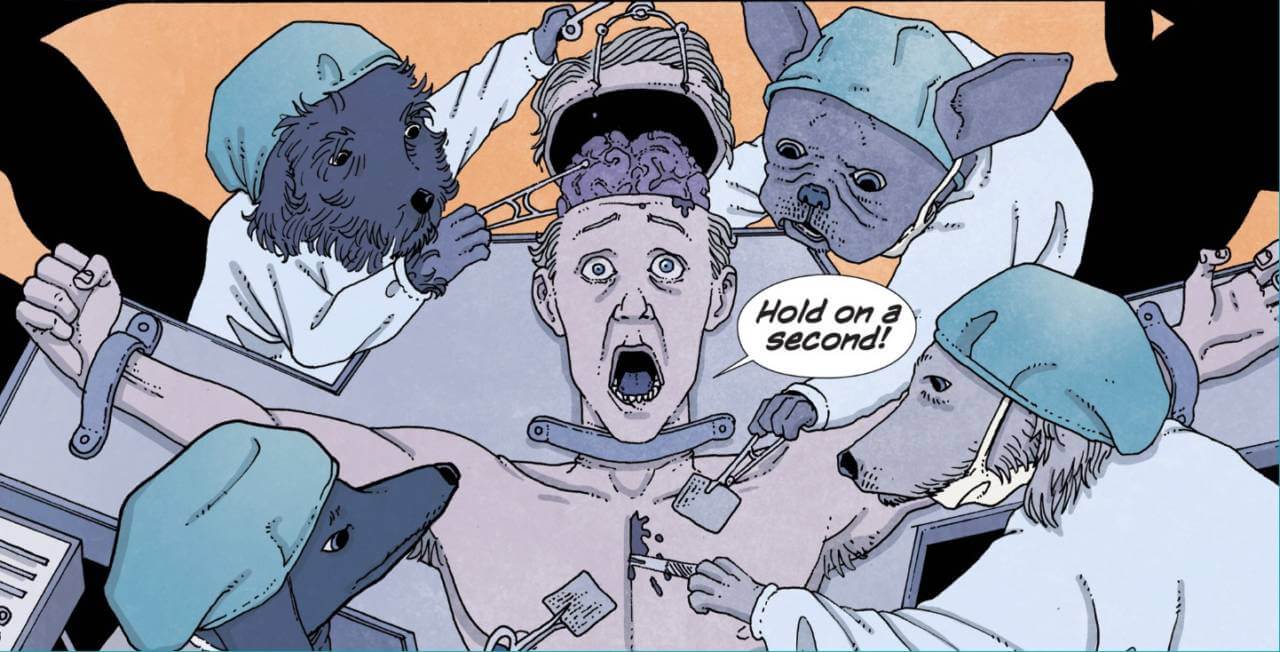
Lots of good horror books this year. This one is kind of an anthology—the stories don’t clearly tie together from issue to issue, except that there’s a really, really creepy ice cream truck driver involved either directly or tangentially. Each story is very different, from an issue where dogs perform brain surgery (above) to one that contained some very nice musical references…

…To say more than that is hard. The stories are horrific and violent, but also can be quite touching—depending on the issue. Anthologies are usually pretty uneven, but every issue of Ice Cream Man has been predictably unpredictable, wildly different from anything else on the stands, and of the highest quality.=
7. Thanos/Cosmic Ghost Rider by Donny Cates and Geoff Shaw (Marvel)
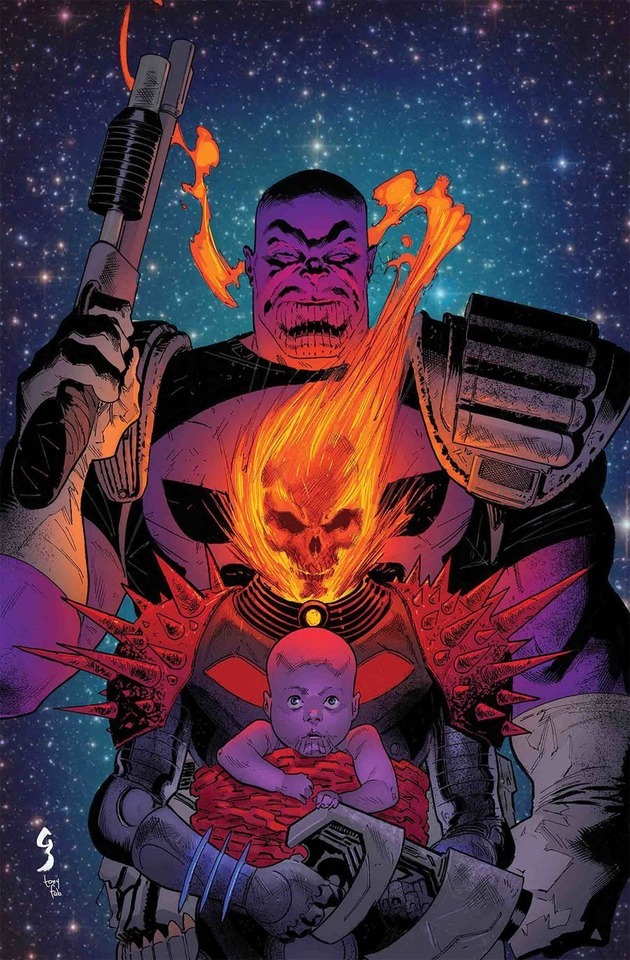
Finally! Someone has figured out a new take on Ghost Rider that’s actually worth reading! He’s Frank Castle, and he’s protecting a baby Thanos! That’s the idea behind Cosmic Ghost Rider, which serves as a humorous postscript to Cates’ impressive Thanos series, in which we see the future and see him, finally, win it all forever.
I know the rumors (or accusations), which are that Marvel stole this idea from Jim Starlin and basically robbed us of a final Starlin Thanos tale, but I have to say…Cates’ work is almost as good as Starlin’s. And that’s really saying something, as Jim Starlin’s Thanos work is definitive.
6. Coyotes by Sean Lewis and Caitlin Yarsky (Image)
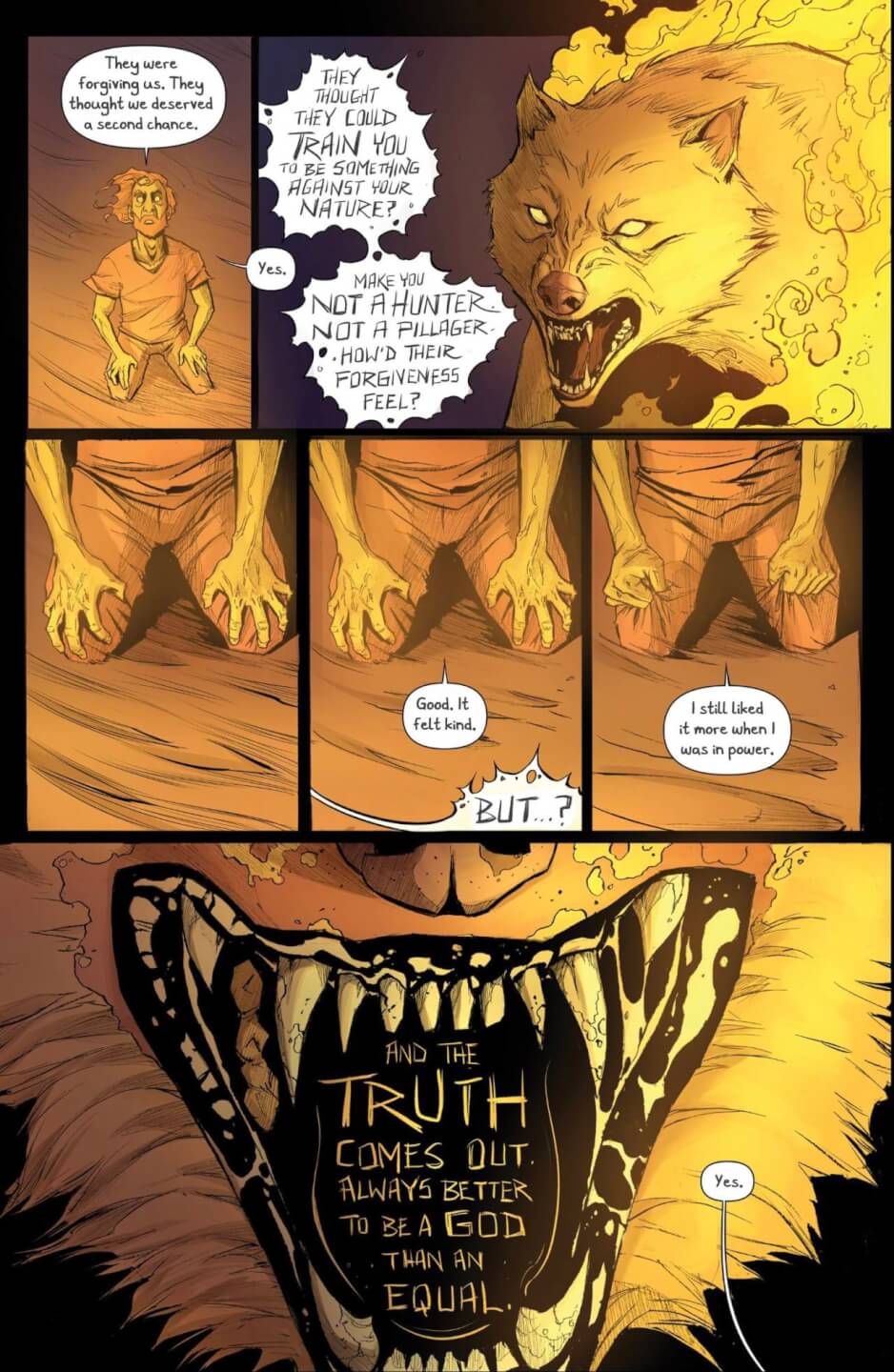
A bilingual tale of a young girl with the fantastic, violent ability to protect women from mystical coyotes who patrol the border. Yeah, it’s a werewolf book, but don’t get misled. This is not your average horror book. It’s got strong political overtones, particularly on aspects of race and gender, coupled with excellent character development, and perfectly suited, highly stylized art that will take your breath away.
5. Heroes in Crisis by Tom King and Clay Mann (DC)
Heroes in therapy. A murder mystery. More brain-twisting, emotionally resonant superhero writing from Tom King, who has emerged as the best writer in comics today.
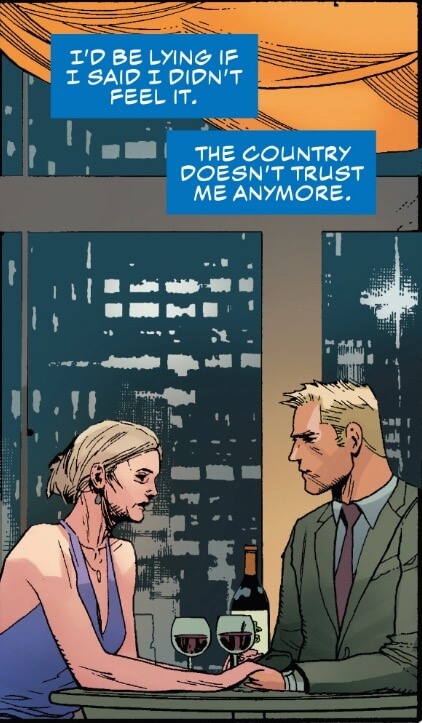
4. Captain America by Mark Waid and Chris Samnee, then by Ta-Nehisi Coates and Lenil Yu (Marvel)
Marvel made Captain America an anti-hero, and Mark Waid explored the character’s heroism. Then, Coates put Captain America at the bottom of the barrel. The hero of Africa and Earth became a science fiction Moses and the symbol of all that’s right with America played the role of antihero. By flipping the characters’ situations, Waid and Coates found a way to do fresh character work on a guy who is over a half-century old
3. Kill or Be Killed by Ed Brubaker and Sean Phillips (Image)
Ed and Sean concluded their latest masterpiece. These guys can do no wrong. And I have to say, I was doubtful about this one. A serial vigilante/killer who is chased by visions of a demon? Seems like we’ve seen this before, both in real life and fiction. But leave it to these two to prove that it’s not the story, it’s the characters—it’s not the concept, it’s the execution. These guys are masters of the craft, and shame on me for ever doubting them.
Oh, and it’s already on the way to a film adaptation by no less than the director of John Wick.
Perfect.

2. Mister Miracle by Tom King and Mitch Gerads (DC)
The best book about fatherhood, motherhood, and the New Gods ever made. I’ve written several times about this book throughout the year, and it’s the book I most looked forward to reading all year. There’s only one person who wrote a better comic this year, and…It’s the same person.
1. Batman by Tom King and Various Artists (DC)

Tom King spent the first half of 2018 building to the wedding between Catwoman and Batman, and most of us knew it would never really happen. But it wasn’t the journey, it was the destination. Each arc focused on a different criminal’s relationship with Batman, and each had a different, amazing artist. When it came to Joker, he and Batman’s fiancee slowly bled out on the floor of a church, telling tales and plotting each other’s demise, and psychoanalyzing the man they both love more than anything. Absolute Tarantino brilliance. No one needs to write the next Batman movie—this is it.
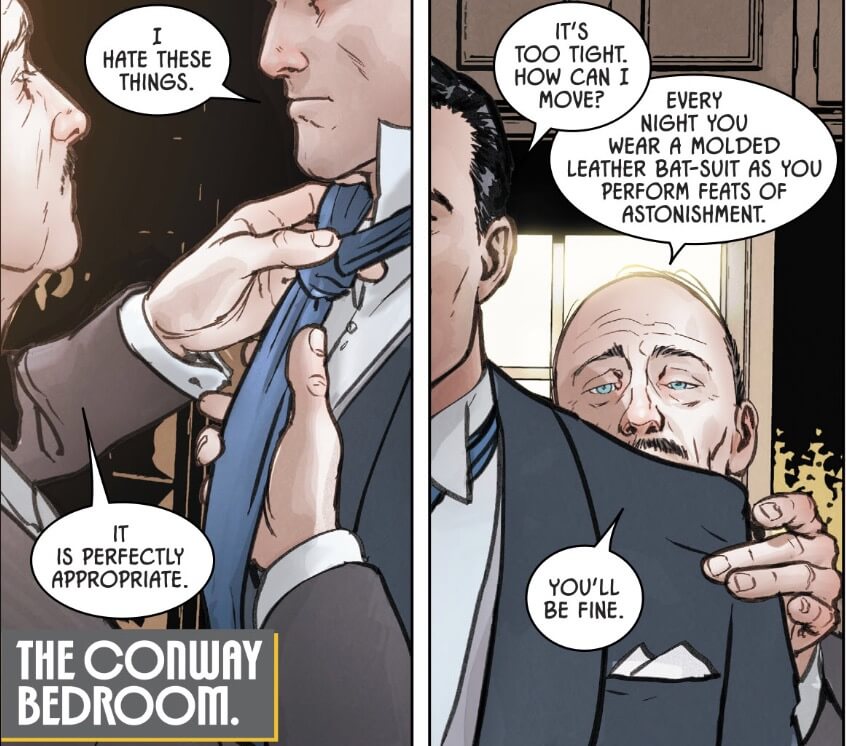
And then we got to the promised issue: #50. And once again, it was the quiet character moments, like the one above (referencing Gerry Conway) powerfully depicted the intimacy in Batman and Alfred’s relationship. It didn’t stretch the boundaries or even develop the characters, really, but we saw a level of affection never before seen in Batman and, in fact, rarely seen in comics at all…

Batman and Alfred hugged for what I’m pretty sure was the first time in history.
Why don’t we see more bro hugs in comics? In real life, they’re happening all day every day between macho guys who make it their career to save lives and risk their own. Why don’t we see them? Because most comic book writers have never done it. Tom King has. His personal history as a combat operative lends a humanity to Batman we’ve simply never seen before.

And back to #50 again: Almost every page was drawn by a past Batman artist, and the references to past creators were bountiful.

And by the end, we saw Batman as vulnerable, nervous to get married, truly in love. And we saw Alfred, the proud parental stand-in, staying right there with him—understanding him in a way even deeper than Catwoman.
Ultimately, we all know, she chose not to marry him because he “needed” to be unhappy to be Batman (although Alfred said the opposite, opining that the wedding was a blessing because he needed a little joy in order to continue his life as Batman). And that led to an all out war with Bane. Yeah, we got to the action eventually. But there was no rush.
Tom King’s Batman is, quite simply, the perfect superhero comic.
